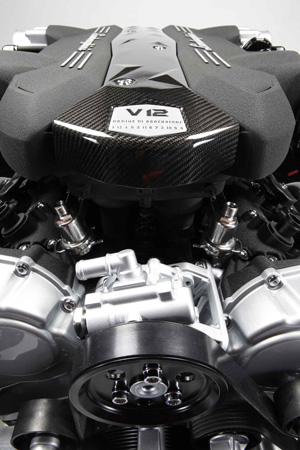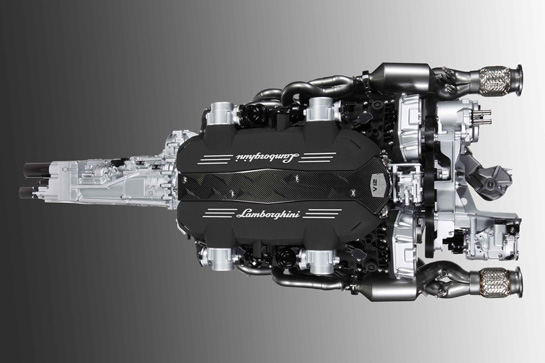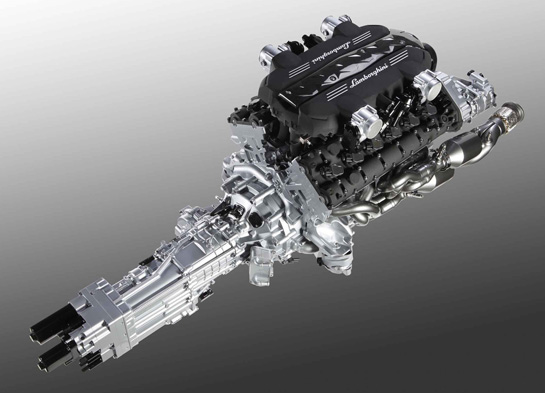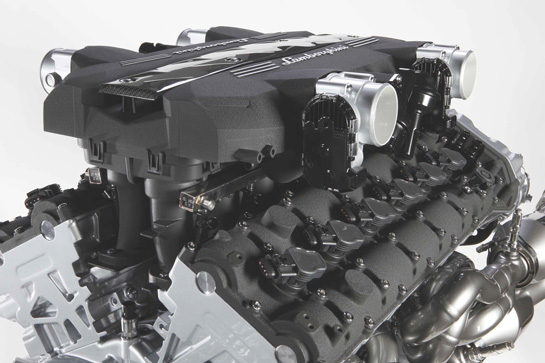Sant’Agata Bolognese, November 15, 2010 – Automobili Lamborghini is embarking on a highly innovative chapter in the company’s history with an all new V12 engine and a new high performing seven speed transmission. The new powertrain will enter production early 2011.
The new twelve-cylinder is 6.5 liters in total displacement, in order to produce 525 kW (700 hp) and maximum torque of 690 Newton meters.
The perfect complement is a completely new transmission concept for super sports cars: the “Lamborghini ISR” automated manual gearbox combines minimal shift times and the emotional gearshift that customers expect from a super sports car at the very top of the premier league.
Starting with a clean sheet of paper
The R&D team started with a clean sheet of paper for the development of the new twelve cylinder, known internally as the L539. Goals were listed as:
– low weight
– high power output
– fuel consumption and gas emissions reduced significantly
The new V12 Lamborghini has a classic cylinder bank angle of 60 degrees, and is very compact: it is only 665 millimeters from top to bottom, and its width, including the exhaust manifold, is only 848 millimeters, while its length is 784 millimeters. Its weight is 235 kg.
Optimized for high revving and low weight
The crankcase on the new engine is made from an aluminum-silicon alloy and has an open-deck construction with steel cylinder liners.
The engine has a displacement of 6,498 cm3 and cylinder spacing 103.5 millimeters, while bore and stroke measures are 95 and 76.4 millimeters respectively.
The engine has a short-stroke layout, excellent for high-revving and low internal friction.
The two four-valve cylinder heads are likewise made from sand-cast aluminum-silicon alloy.
The twelve pistons and con-rods are, respectively, in forged alloy and steel.
The maximum piston speed at 8,250 rpm is only 21 meters per second.
The combustion chambers were carefully engineered and the compression ratio is of 11.8:1.
Inlet and outlet valve timing is electronically controlled.
The new engine is mounted 60 millimeters lower than the V12 in the Murciélago, with the associated benefits in respect of center of gravity and lateral dynamics.
Electronics devised entirely by Lamborghini
Another highlight is the electronic engine management, which was developed in its entirety by engineers at Lamborghini. The system consists of the main ECU, a secondary “smart actuators” and two additional black boxes that function as “smart sensors”. Because speed is everything for an engine like this, some ECU control and connection functions are handled by the smart actuators, making the ECU faster.
The two smart sensors are constantly monitoring combustion in real time, each ignition in every cylinder. Each spark plug is powered by an individual ignition coil and function as “sensors”; the two auxiliary control units monitor the power signal after every ignition and can immediately identify irregularities in the combustion process through ionization phenomena. This data is used to continually optimize engine management, benefiting both performance and fuel consumption.
High performance in every dimension
All these technical highlights come together to create a high-performance power unit like no other engine. The maximum output of 515 kW (700 hp) at 8,250 rpm is an impressive statement in itself. The maximum torque is 690 Newton meters and is available at 5,500 rpm.
However, it is not the engine alone that defines the character and driving characteristics of a super sports car.

New system has main ECU, secondary smart actuators and two additional black boxes that function as smart sensors.
Another key element is the transmission.
The ratios must be perfectly arrayed and enable optimum power delivery from the engine. For maximum vehicle performance, shift times should be less than the blink of an eye.
Operation must be clear and straightforward, via two ergonomic shift paddles behind the steering wheel.
The engineers in the R&D Department opted for a robotized gearbox as the “companion” of the new V12 power unit, however, in a very special iteration: the Lamborghini ISR transmission.
This robotized gearbox combines extremely fast shift times, almost 50% less than dual-clutch transmission with the benefits of a manual transmission in terms of weight and compact dimensions.
The Lamborghini ISR transmission shifts around 40 percent faster than the transmission in the Gallardo. And that is already one of the world’s fastest automated manual gearboxes.
Compact construction, low weight
The new transmission system incorporates a total of seven hydraulic valves, with pressure supplied by an electric pump. The double-plate clutch is also hydraulically actuated. All system components are contained within one casing. The total weight of the transmission is only 70 kilograms.
Lamborghini drivers can choose between three operating modes:
– The Strada mode offers highly comfort-oriented shifting, with fully-automatic also an option.
– The Sport mode has a dynamic set-up in terms of shifting points and times.
– The Corsa mode delivers the maximum shift strategy for race track driving. This mode also includes Launch Control, the automatic function for maximum acceleration from a standing start.
Integrated electronic control system
The excellent performances are possible only by a fast communication architecture through the several powertrain ECUs which consider the powertrain as ONE-system (un unico sistema) in the car.

The new Lamborghini engine is very compact: it is only 665 millimeters from top to bottom, and its width, including the exhaust manifold, is only 848 millimeters, while its length is 784 millimeters.
The fully electronic controlled coupling device for the front wheels (the ‘old’ viscous coupling) is another key point of the powertrain: it is able to continuously distribute the right torque to the front wheels for always attaining the best performance aspired to by the driver.
The torque distribution to the front wheels can vary continuously from 0% to 60% of the total torque available.
Source: Lamborghini and Roberto Motta


i’m feeling old.i’m remembering fangio and moss and the cars they drove.even that new fangeld injected 300sl.you sort of had a handle on all that.the thing was simple 4cycle springs and coils and power steering by arm power.even those novis at indy had nothing but a power tractor engine.this new lambo frankinstein i guess is where its at.